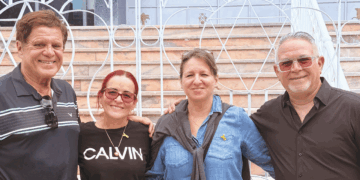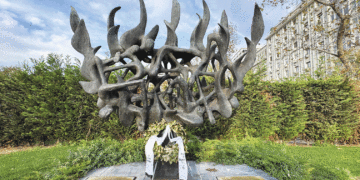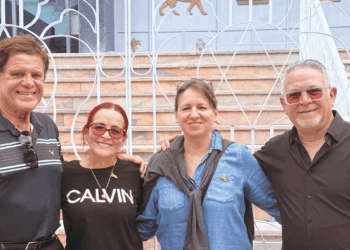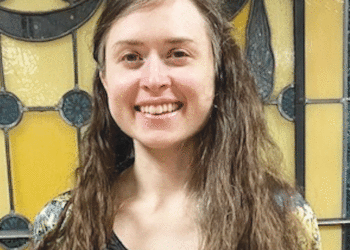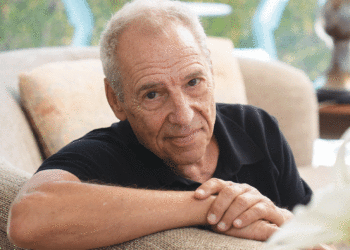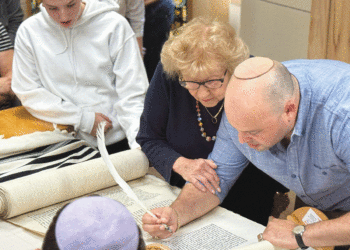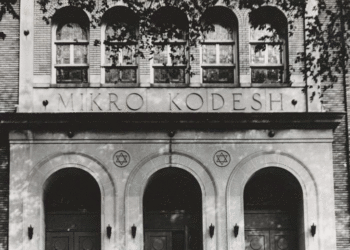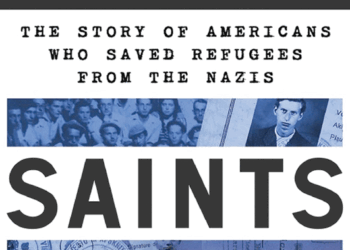Reviewed by NEAL GENDLER
Best known among Shoah rescuers is Raoul Wallenberg, the courageous Swede who saved thousands of Hungarian Jews.
Known less is American Varian Fry, whose legal and illegal operation in France got 2,000 people, including a number of prominent artists and intellectuals, beyond Nazi reach.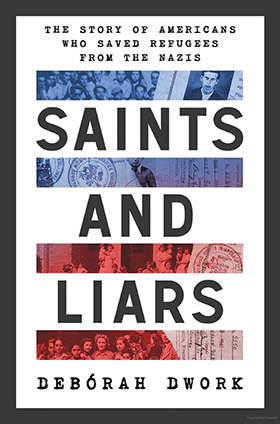
But Waitstill and Martha Sharp? Moses Beckelman? Marjorie and Ross McClelland?
They and others who acted with devotion and courage get belated, deserved recognition in Saints and Liars by Debórah Dwork.
“This book unearths the history of a number of Americans — Quakers, Jews, Unitarians — who became both saints and liars as they sought to save lives,” says Dwork, director of the Center for the Study of the Holocaust, Genocide, and Crimes Against Humanity at City University of New York’s graduate center.
Dwork’s fascinating, deeply researched account of three couples and two individuals includes photos, maps and an index.
There’s also a recurrent, maddening theme: organizations bickering, competing, not cooperating. But despite rivalries, risks and physical and emotional exhaustion, Dwork’s subjects saved lives.
“Women featured prominently,” finding “unimagined avenues for independent action,” she says.
Waitstill Sharp, 37, a Massachusetts Unitarian minister, and his social worker wife Martha, 33, arrived in Prague in February 1939 to help 250,000 refugees from German-held Sudetenland.
“Articulate, personable and handsome,” they joined local agencies providing food, housing and escape, especially for German Social Democrats and 2,500 German and Austrian refugee Jews, Dwork says.
That brought Nazi attention: tailing, hotel lobby spies and a search of their room. Things worsened in March, when Germany took the rest of Czechoslovakia and its 118,000 Jews. Martha took risks, evading a tail to escort a wanted man to the British Embassy and taking to London 35 people in danger of arrest.
When mass emigration became impossible, the Sharps tried placing individuals with out-of-country openings matching their competencies.
“Finances were key to clandestine escape or lawful flight. Neither the U.S. government nor philanthropic contributors wanted dollars to flow into a German-controlled banking system,” Dwork says. The Sharps arrived with $41,000 (about $907,500 today).
“Applicants likely to make cultural contributions were granted money to escape.” Martha became primarily responsible for open and clandestine rescue, and Waitstill developed illegal currency exchange and a way escapees could claim cash he’d deposited outside the country.
Their work fed 350 refugees twice a day for a year and a half, housed families and “handled the emigration of 3,500 families” legally and secretly. Their staff of four Jewish couples couldn’t escape.
Waitstill was in Switzerland when Martha was warned of arrest. She left for Paris on Aug. 15, 1939, the day before the Gestapo came.
The Sharps later did relief work from Lisbon, and Martha brought 27 children and 11 adults from France to New York.
“Martha’s tenure in Prague … was but the beginning of a previously unimagined professional trajectory,” Dwork says.
Martha then traveled America to raise funds for the Unitarian Service Committee, speaking also for Hadassah’s Youth Aliyah, which sent endangered Jewish adolescents to Palestine. In 1943, she founded Children to Palestine. Postwar, she won a primary election for Congress.
Moses Beckelman, a social worker and accountant in his 30s, was in Lithuania for the American Jewish Joint Distribution Committee (JDC). He was sent to Vilna, which the invading USSR had transferred to Lithuania from Poland, creating a wave of Jewish refugees.
He arrived the day after the Soviet army left, taking with it “everything that it might find useful,” impoverishing the city. Soon, Vilna’s Poles, including police, began a pogrom.
Most refugees were educated men, many previously prosperous. Beckelman helped provide food, housing and clothing, “but perhaps most important,” Dwork says, was realizing refugees’ need to emigrate.
“Thanks in no small measure to his efforts, thousands managed to flee,” she says. Independent of him, so did thousands more with honorary Dutch counsel Jan Zwartendijk’s Curaçao visas and Japanese counsel Chiune Sugihara’s travel visas to Japan.
Beckelman left Lithuania in February 1941. Working for the JDC in Paraguay, he was a conduit to headquarters for Laura Margolis in Shanghai.
Margolis, 38 or 39, a social worker who knew six languages, was sent in May 1941 by the National Refugee Service but paid by JDC to help thousands of Jewish refugees emigrate elsewhere.
She found a poorly run refugee assistance committee feuding with a second refugee organization claiming it deserved more funds per capita.
She worked well with U.S. officials, but in July, the State Department forbade visas to refugees with close relations in Axis-occupied countries or the USSR; almost all refugees did have such relations. Margolis turned to relief work but left in frustration.
JDC soon sent her back, empowered to take charge. America’s war entry dried up funds, but her cordial relationship with the Japanese captain overseeing Jewish affairs allowed her to borrow, promising postwar JDC repayment.
Communication with JDC ended in May 1942. She and assistant Manny Siegel resigned and were put in camps until leaving in an exchange in September 1943.
Doctoral student Ross McClelland and his child psychologist wife Marjorie, both 26, arrived in Rome in October 1940 to run the American Friends Service Committee (AFSC) relief operation for Jews and political refugees hoping to sail to America.
When emigration became extremely difficult and the United States forbade transfer of funds to Italy, they joined 40 overworked people at the French port of Marseilles.
Martha became the liaison with Quaker headquarters in Philadelphia and multilingual Ross supervised AFSC’s internment camp program, helping 16,000 people housed in squalid conditions.
Martha ran a program of sending children to the United States via Lisbon, requiring agonizing choices. Several hundred were sent — most of them Jews despite headquarters’ pleas for more gentiles for broader program appeal in the United States.
The couple lived in one room of a third-class hotel on a poor diet of potatoes, turnips, cabbage and carrots. They mended worn clothes and were allowed only one bath every two weeks.
In two years, the AFSC and YMCA helped 10,000 people emigrate, Dwork says. The McClellands transferred to Switzerland before Germany occupied Vichy France in 1942.
Robert Dexter, 56, was executive director of the Unitarian Service Committee’s European operations. He and wife Elizabeth, 56, a former Skidmore history department head, went to Lisbon in 1941.
Neutral Portugal was a port to freedom for those with visas abroad and funds for ship fare. German occupation of all France brought a wave of refugees.
“The Unitarians cared for the undocumented because neither the JDC nor the Friends wished to,” Dwork says.
The Unitarians focused on professionals, intellectuals and leaders they believed best would benefit the postwar world. The Dexters also became agents of the OSS, predecessor to the CIA, as did some other relief and rescue workers.
These couples’ wives were full partners in the physical and emotionally exhausting work, but unpaid. But when Robert Dexter left for the War Refugee Board in 1944, Elizabeth took over the operation, paid $4,000. Robert had been paid $9,000.
***
Neal Gendler is a Minneapolis writer and editor.
(American Jewish World, February 2025)


